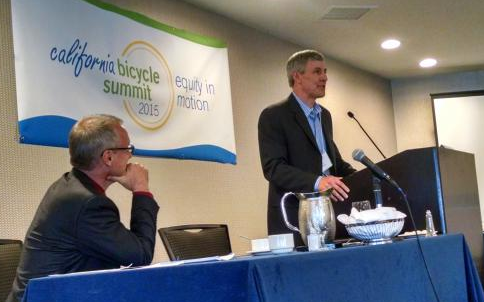
We're still digesting all the reports and conversations that occurred at the California Bicycle Coalition's biannual bike summit in San Diego this week. In addition to some very hard conversations about equity and diversity in bike advocacy—a subject that needs its own report—there were more planner-y presentations about on-the-ground bike issues. Caltrans was very active at the summit, with various Caltrans employees giving presentations on bicycle safety goals within the Strategic Highway Safety Plan, new sustainability goals for the department, and the Active Transportation Program.
And at a rousing lunchtime speech on the last day of the summit, Caltrans director Malcolm Dougherty announced the launch of the first statewide bicycle and pedestrian master plan.
The plan, which is just in its beginning stages, is slated to be a policy plan, “not a list of projects,” according to program manager Scott Forsythe. It won't be completed until February 2017. So far the website has been launched and a technical advisory committee is being formed.
Dougherty began by saying it was great that California moved up from ninth to eighth on the League of American Bicyclists' 2015 ranking of "bicycle friendly" states. “But this is California,” he said. “How is it that we are not the runaway number one bicycle-friendly state?”
He also addressed the question of whether the Active Transportation Program is adequately funded. Advocates have been saying for years that the amount of money going to the ATP—about one percent of the state transportation budget—is too little, given that the state bicycle mode share is higher than that. “Over a decade, the amount of money going to the ATP will add up to about $1 billion,” said Dougherty, “and it's way oversubscribed. But the ATP is not, and should not be, the only investments we make in active transportation,” he added, to enthusiastic applause.
He mentioned the main statewide transportation funding plans, the State Highway Improvement Plan (STIP) and the State Highway Operation and Protection Program (SHOPP), and said those plans “need to take all modes into account in transportation projects. Why? To enhance livability and the economy,” he said. “Not car throughput.”
It could have been a little strange to hear the head of Caltrans saying that, given that Caltrans has been the source of much of the car-centric planning in the state. But changes happening at Caltrans headquarters in the last year or so—if not necessarily trickling down to the local districts—have been sounding pretty good for bicyclists and pedestrians. Dougherty has been pushing through a series of reforms, including hiring Steven Cliff as Assistant Director for Sustainability (Cliff also gave several presentations at the summit). And Caltrans has formally adopted the goal of tripling bike mode share and doubling walking trips by 2020.
At a different summit session, bike plan manager Forsythe had outlined the work needed to complete the plan, including formulating goals and strategies to reach those goals, identifying performance measures and data needs, and creating a state bike map that highlights gaps in existing bike networks. The completed plan will include information about safety, best practices, and a reference section bringing together various and sometimes hard-to-find state resources on bicycle and pedestrian planning.
Since this is the first such statewide bike plan in California, it is a huge opportunity to create a really good resource for engineers, planners, and advocates, not just in Caltrans but at city and county transportation planning departments throughout the state.
The website is still pretty barebones, but it does offer a few ways to get involved in the process. For example, there's a short survey to gauge people's personal experience of biking and walking in the area where they live and on a variety of street types. There's also a place to sign up for future updates as the process moves forward. Although there is no public outreach schedule yet, Forsythe expects to hold regional forums, public workshops, and focus groups throughout 2016.
The website, with a link to the survey, can be found here.





